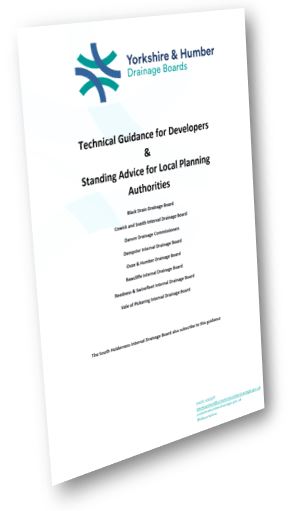Planning and Development Control
The Board has produced technical guidance for developers and standing advice for local planning authorities. Please click on the image below to download this guide.
The Board is not currently a statutory consultee to the town and country planning process but is the Land Drainage Authority and supervising body for drainage matters within its district. We work closely with our Local Planning Authorities (LPAs) and have issued them standing advice on the approach they should take to managing flood risk in the Board’s area.

From a developers point of view it is important to understand that it is unlawful for a development to take place that results in activities that are contrary to the Land Drainage Act 1991 or Local Land Drainage Bylaws, the Board therefore encourages developers to engage with the Board through the planning consultation process. Failure to do so may result in a development gaining planning permission but not land drainage consent, this means a development may not be able to go ahead.
In the Board’s area we would always encourage a developer to think about drainage and flood risk issues first, so before considering any commercial or other viability issues, the developer should first work with his designer to ask:
“is the development at flood risk and how can it be drained without causing a flood risk to its users or increasing flood risk outside of the development?”.
The answer to this question will influence the design and layout of roads, other infrastructure and lastly buildings. Taking the opposite approach e.g.
“firstly, let’s assess how many housing units can this piece of land accommodate”
could result in costly abortive design works if the site is at flood risk or cannot be effectually drained.
The Board will try to comment on all planning applications that may impact flood risk or the operation of the local land drainage system and ask for technical information to support a scheme for drainage or flood risk within an application. If there is insufficient information for the Board to make this decision or officers disagree with the technical approach we will object to the application until sufficient or adequate technical information is submitted through the planning process.

Land Drainage Consent
If anybody wishes to carry out works on or near a watercourse or undertake a development that is likely to have an impact on the local land drainage system, they will need to apply for Land Drainage Consent. This is so the Board can check that proposed works meet acceptable technical standards and appropriate maintenance arrangements are in place.
A Consent may also be in the form of permission from the Board to deviate from Land Drainage Legislation and Local Land Drainage Bylaws.
Failure to obtain consent prior to undertaking works that impact the local land drainage system may mean you are committing an offence.
A copy of the Local Land Drainage Bylaws can be found here.
A copy of the land drainage consent application form can be found here.
Enforcement
If works are carried out in contravention of Local Land Drainage Bylaws or the Land Drainage Act 1991 an offence may have been committed. The Board may decide to take enforcement action including legal action against the transgressor to remedy the unlawful action and shall make and application to recover all costs in doing so.
Maintenance Strips
Although we work with arable farmers to manage crops (temporary planting), without the consent of the Board it is an offence to erect any building or structure, whether temporary or permanent, or plant any tree, shrub, willow or similar growth within 9 meters of a watercourse.

Maintenance strips are essential to allow the Board to undertake its operations in an efficient, and most importantly a safe way. This space is needed to allow access for machinery and the deposition of arisings, such as weed and silt from the watercourse. In exceptional circumstances the Board may consent to a narrower maintenance strip through a land drainage consent.
If in doubt contact us.
Environmental Land Management Schemes
If you are a land owner and you are considering entering a stewardship, ELMS (or similar scheme) and the land you would like to use for this scheme is within 9 meters of a watercourse you may first require the consent of the Board.

Although the Board encourages environmental improvement, we cannot guarantee that damage will not be caused to a scheme as we go about our legal maintenance activities.
Please speak to us before applying for such a scheme.


